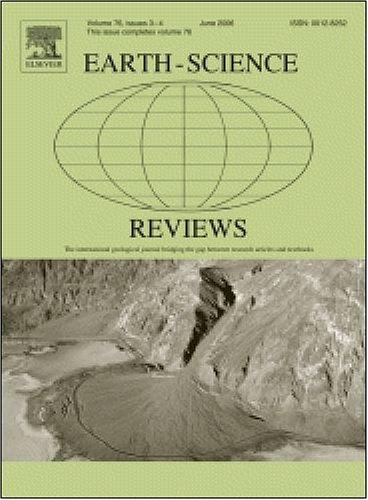Ediacaran-Cambrian Boundary in the Anti-Atlas belt (Morocco): A review of biostratigraphy, chemostratigraphy and geochronology
IF 10.8
1区 地球科学
Q1 GEOSCIENCES, MULTIDISCIPLINARY
引用次数: 0
Abstract
The Ediacaran-Cambrian transition represents a pivotal geological marker, denoting the decline of the Ediacaran biota and the emergence of most modern phyla in an interval marked by perturbations to the carbon cycle (as evidence by carbonate carbon isotopes, δ13Ccarb), biotic turnover, dynamic paleoredox regimes, and magnetic field instability. Following initial international expeditions to the Anti-Atlas belt in Morocco, numerous attempts have sought to pinpoint the exact stratigraphic level of the Ediacaran-Cambrian boundary (E-C) in this important succession, where ca. 3 km of continuous carbonate rocks provide one of the most complete successions for the establishment of a global δ13Ccarb chemostratigraphic reference curve. Subsequently, a growing number of publications have explored the stratigraphy, paleontology, and geochronology of the Ediacaran-Cambrian transition in the Anti-Atlas. Despite extensive efforts, the precise position of the E-C boundary in the Anti-Atlas remains ambiguous, with multiple proposed positions ranging from within the Ouarzazate Group to the lower part of the Tifnout Member (Adoudou Formation, Taroudant Group). Here, we conduct a comprehensive review of the available chemostratigraphic, paleontological, and geochronological data associated with the late Ediacaran-Cambrian Ouarzazate Group and Adoudou Formation within the Anti-Atlas belt. The objective is to refine our understanding of the regional expression of the E-C boundary and offer clarity on the inconsistencies observed among biostratigraphy, chemostratigraphy, and geochronology. This review underscores that the currently proposed boundary relies primarily on the δ13Ccarb excursion, lacking corroboration from other independent markers such as geochronology and globally significant ichnofossil assemblage constituents. Additionally, through the integration of newly available data and enhanced global chemostratigraphy, biostratigraphy, and geochronology, our findings suggest that the E-C boundary within the Western Anti-Atlas may be positioned as low as within the upper unit of the Tabia Member. However, this interpretation relies heavily on a Fortunian age for the ichnotaxa Monomorphichnus, in the absence of co-occurring specimens of the boundary-defining ichnospecies Treptichnus pedum. Moreover, a revised assessment of chemostratigraphic correlation and geochronological markers indicates that the Tabia and Tifnout members in the Central and Eastern Anti-Atlas do not correlate with the same named members in the Western Anti-Atlas. Both the Tabia and Tifnout members of the Central-Eastern Anti-Atlas may instead correlate with the middle part of Tifnout Member in the Western Anti-Atlas. This implies a late Ediacaran to early Cambrian ca. 10 m.y stratigraphic gap in the Central-Eastern Anti-Atlas and hence the E-C boundary in the Central-Eastern Anti-Atlas is likely situated within the unconformity between the Ouarzazate and Taroudant Groups. Lastly, we present unresolved questions regarding the biogenicity and affinities of some described discoidal structures and calcified microfossils from the Tabia Member, with the aim of further stimulating active engagement of the global scientific community in the establishment of robust paleontological and chronostratigraphic constraints for the E-C boundary within the Anti-Atlas belt.
摩洛哥反阿特拉斯带埃迪卡拉-寒武系界线:生物地层学、化学地层学和地质年代学综述
埃迪卡拉纪-寒武纪的过渡是一个关键的地质标志,标志着埃迪卡拉纪生物群的衰落和大多数现代门的出现,其标志是碳循环的扰动(作为碳酸盐碳同位素δ13Ccarb的证据),生物更替,动态古氧化还原制度和磁场不稳定。在对摩洛哥反阿特拉斯带进行最初的国际考察之后,许多人试图确定埃迪卡拉-寒武纪界线(E-C)在这一重要序列中的确切地层水平,其中约3公里的连续碳酸盐岩为建立全球δ13Ccarb化学地层参考曲线提供了最完整的序列之一。随后,越来越多的出版物探索了反阿特拉斯埃迪卡拉-寒武纪过渡的地层学、古生物学和地质年代学。尽管进行了广泛的努力,但Anti-Atlas中E-C边界的确切位置仍然不明确,从Ouarzazate组内部到Tifnout组下部(Adoudou组,Taroudant组)的多个位置都有。在此,我们对反阿特拉斯带内埃迪卡拉晚期-寒武系瓦尔扎扎特群和阿杜斗组的化学地层、古生物学和地质年代学资料进行了综合评述。目的是完善我们对E-C边界区域表达的理解,并澄清生物地层学、化学地层学和地质年代学之间观察到的不一致。目前提出的边界主要依赖于δ13Ccarb偏移,缺乏其他独立标志的佐证,如地质年代学和具有全球意义的技术化石组合成分。此外,通过整合新获得的数据和增强的全球化学地层学、生物地层学和地质年代学,我们的研究结果表明,西部反阿特拉斯的E-C边界可能位于塔比亚段的上部单元内。然而,这种解释在很大程度上依赖于单形鱼分类群(Monomorphichnus)的fortunan年龄,因为没有定义边界的鱼种Treptichnus pedum的共存标本。此外,对化学地层对比和年代学标志的修正评价表明,中部和东部的Tabia和Tifnout段与西部的Tabia和Tifnout段不具有相关性。中东部反阿特拉斯的Tabia和Tifnout成员可能与西部反阿特拉斯的Tifnout成员中部相关。这意味着中-东部反阿特拉斯存在晚埃迪卡拉世至早寒武世约10 m的地层缺口,因此中-东部反阿特拉斯的E-C边界可能位于Ouarzazate群与Taroudant群之间的不整合之中。最后,我们提出了一些尚未解决的关于Tabia成员的盘状结构和钙化微化石的生物原性和亲和力的问题,旨在进一步促进全球科学界积极参与建立反阿特拉斯带E-C边界的古生物学和年代地层学约束。
本文章由计算机程序翻译,如有差异,请以英文原文为准。
求助全文
约1分钟内获得全文
求助全文
来源期刊

Earth-Science Reviews
地学-地球科学综合
CiteScore
21.70
自引率
5.80%
发文量
294
审稿时长
15.1 weeks
期刊介绍:
Covering a much wider field than the usual specialist journals, Earth Science Reviews publishes review articles dealing with all aspects of Earth Sciences, and is an important vehicle for allowing readers to see their particular interest related to the Earth Sciences as a whole.
 求助内容:
求助内容: 应助结果提醒方式:
应助结果提醒方式:


